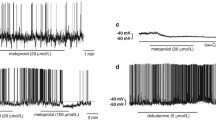Abstract
In adult male Sprague-Dawley rats anesthetized with pentobarbital sodium, we elucidated the molecular consequence of central α2-adrenoceptor activation. The hypotensive and negative chronotropic and inotropic actions of the α2-adrenoceptor agonist guanabenz were used as our experimental index. Intracerebroventricular administration of pertussis toxin (2.5 µg) significantly attenuated the cardiovascular suppressant effects of the aminoguanidine compound (100 µg/kg i.v.). However, application of N-ethylmaleimide (0.125 or 0.250 µg), phorbol 12-myristate 13-acetate (1.25 or 2.50 µg), cholera toxin (1.25 or 2.50 µg) or forskolin (12.5 or 25.0 µg) into the lateral cerebral ventricle elicited no appreciable blunting effect on the circulatory depression produced by guanabenz. These results were essentially duplicated when pertussis toxin (0.125 or 0.250 µg), N-ethylmaleimide (0.0125 or 0.05 µg), phorbol 12-myristate 13-acetate (0.125 or 0.25 µg), cholera toxin (0.125 or 0.25 µg) or forskolin (1.25 or 2.50 µg) was microinjected bilaterally to the nucleus reticularis gigantocellularis, a medullary site believed to be intimately related to the antihypertensive action of guanabenz. These findings suggest that stimulation of the α2-adrenoceptors in the medulla oblongata may result in the activation of a pertussis toxin-sensitive GTP-binding regulatory protein. They further suggest that the biologic signals subsequent to this action may not be linked to Gs, Gi or Gp but possibly Go.
Similar content being viewed by others
References
Allgaier C, Feuerstein TJ, Jackisch R, Hertting G. Islet-activating protein (pertussis toxin) diminishes α2-adrenoceptor-mediated effects on noradrenaline release. Naunyn Schmiedebergs Arch Pharmacol 331:235–239;1985.
Allgaier C, Feuerstein TJ, Hertting G. Nethylmaleimide (NEM) diminishes α2-adrenoceptor-mediated effects on noradrenaline release. Naunyn Schmiedebergs Arch Pharmacol 333:104–109;1986.
Baum T, Stropshore AT. Studies on the centrally mediated hypotensive activity of guanabenz. Eur J Pharmacol 37:31–44;1976.
Boyer JL, Garcia A, Posadas C, Garcia-Sainz JA. Differential effects of pertussis toxin on the affinity state for agonists of renal α1- and α2-adrenoceptors. J Biol Chem 259:8076–8079;1984.
Cassel D, Selinger Z. Mechanism of adenylate cyclase activation by cholera toxin: Inhibition of GTP hydrolysis at the regulatory site. Proc Natl Acad Sci USA 74:3307–3311;1977.
Chan SHH, Lin AMY. Correlated effects of guanabenz on single-neuron activity in the nucleus reticularis gigantocellularis, systemic arterial pressure and heart rate in the rat. Neuropharmacology 27:157–162;1988.
Chan SHH, Ong BT. A simple experimental index for the evaluation of inotropic responses. J Pharmacol Methods 18:23–29;1987.
Chen CH, Chan SHH. Involvement of postsynaptic α2-adrenoceptors and guanine nucleotide-binding protein in guanabenz-induced cardiovascular suppressant effects in the rat. Neurosci Lett 105:183–188;1989.
Daly JW, Padgett W, Seamon KB. Activation of cyclic AMP-generating systems in brain membranes and slices by the diterpene forskolin: Augmentation of receptor-mediated responses. J Neurochem 38:532–544;1982.
Fredholm BB, Lindgren E, Lindström K. Treatment with N-ethylmaleimide selectively reduces adenosine receptor-mediated decreases in cyclic AMP accumulation in rat hippocampal slices. Br J Pharmacol 86:509–513;1985.
Freissmuth M, Casey PJ, Gilman AG. G proteins control diverse pathways of transmembrane signaling. FASEB J 3:2125–2131;1989.
Fu MJ, Lin KS, Chan JYH, Chan SHH. Participation of pertussis toxin-sensitive GTP-binding regulatory proteins in the suppression of baroreceptor reflex by neurotensin in the rat. Regul Pept 37:167–180;1992.
Gill DM, Meren R. ADP-ribosylation of membrane proteins catalyzed by cholera toxin: Basis of the activation of adenylate cyclase. Proc Natl Acad Sci USA 75:3050–3054;1978.
Gilman AG. G proteins: Transducers of receptor-generated signals. Annu Rev Biochem 56:615–649;1987.
Hescheler J, Rosenthal W, Trautwein W, Schultz G. The GTP-binding protein, Go, regulates neuronal calcium channels. Nature 325:445–447;1987.
Huang KP. The mechanism of protein kinase C activation. Trends Neurosci 12:425–432;1989.
Jakobs KH, Lasch P, Minuth M, Aktories K, Schultz G. Uncoupling of α-adrenoceptormediated inhibition of human platelet adenylate cyclase by N-ethylmaleimide. J Biol Chem 257:2829–2833;1982.
Katada T, Ui M. Direct modification of the membrane adenylate cyclase system by isletactivating protein due to ADP-ribosylation of a membrane protein. Proc Natl Acad Sci USA 79:3129–3133;1982.
Lim HC, Chong OK, Chan SHH. Participation of nucleus reticularis gigantocellularis in guanabenz-promoted hypotension, decrease in cardiac contractility and bradycardia in rats. Neuropharmacology 24:1241–1246;1985.
Lim HC, Chong OK, Chan SHH. Characterization of α-adrenoceptors in the nucleus reticularis gigantocellularis involved in the cardiovascular depressant effects of guanabenz in the rat. Neuropharmacology 27:243–249;1988.
Lipscombe D, Kongsamut S, Tsien RW. α-Adrenergic inhibition of sympathetic neurotransmitter release mediated by modulation of N-type calcium-channel gating. Nature 340:639–642;1989.
Nomura Y, Kawata K, Kitamura Y, Watanabe H. Effects of pertussis toxin on the α2-adrenoceptor-inhibitory GTP-binding protein-adenylate cyclase system in rat brain: Pharmacological and neurochemical studies. Eur J Pharmacol 134:123–129;1987.
Schoffelmeer ANM, Mulder AH.3H-Noradrenaline release from rat neocortical slices in the absence of extracellular Ca2+ and its presynaptic alpha2-adrenergic modulation. Naunyn Schmiedebergs Arch Pharmacol 323:188–192;1983.
Seamon KB, Daly JW. Forskolin, cyclic AMP and cellular physiology. Trends Pharmacol 4:120–123;1983.
Starke K. Presynaptic α-adrenoceptors. Rev Physiol Biochem Pharmacol 107:73–146;1987.
Sternweis PC, Robishaw JD. Isolation of two proteins with high affinity for guanine nucleotides from membranes of bovine brain. J Biol Chem 259:13806–13813;1984.
Surprenant A, Horstman DA, Akbarali H, Limbird LE. A point mutation of the α2-adrenoceptor that blocks coupling to potassium but not calcium currents. Science 257:977–980;1992.
VanDongen AMJ, Codina J, Olate J, Mattera R, Joho R, Birnbaumer L, Brown AM. Newly identified brain potassium channels gated by the guanine nucleotide binding protein Go. Science 242:1434–1437;1988.
Watson SP, Lapetina EG. 1,2-Diacylglycerol and phorbol ester inhibit agonist-induced formation of inositol phosphates in human platelets: Possible implications for negative feedback regulation of inositol phospholipid hydrolysis. Proc Natl Acad Sci USA 82:2623–2626;1985.
Williams JT, Henderson G, North RA. Characterization of α2-adrenoceptors which increase potassium conductance in rat locus coeruleus neurones. Neuroscience 14:95–101;1985.
Author information
Authors and Affiliations
Rights and permissions
About this article
Cite this article
Chen, C.H., Lin, K.S. & Chan, S.H.H. Further elucidation of a pertussis toxin-sensitive transmembrane signaling mechanism involved in central α2-adrenoceptor activation in the rat. J Biomed Sci 1, 13–18 (1993). https://doi.org/10.1007/BF02258335
Received:
Accepted:
Issue Date:
DOI: https://doi.org/10.1007/BF02258335




